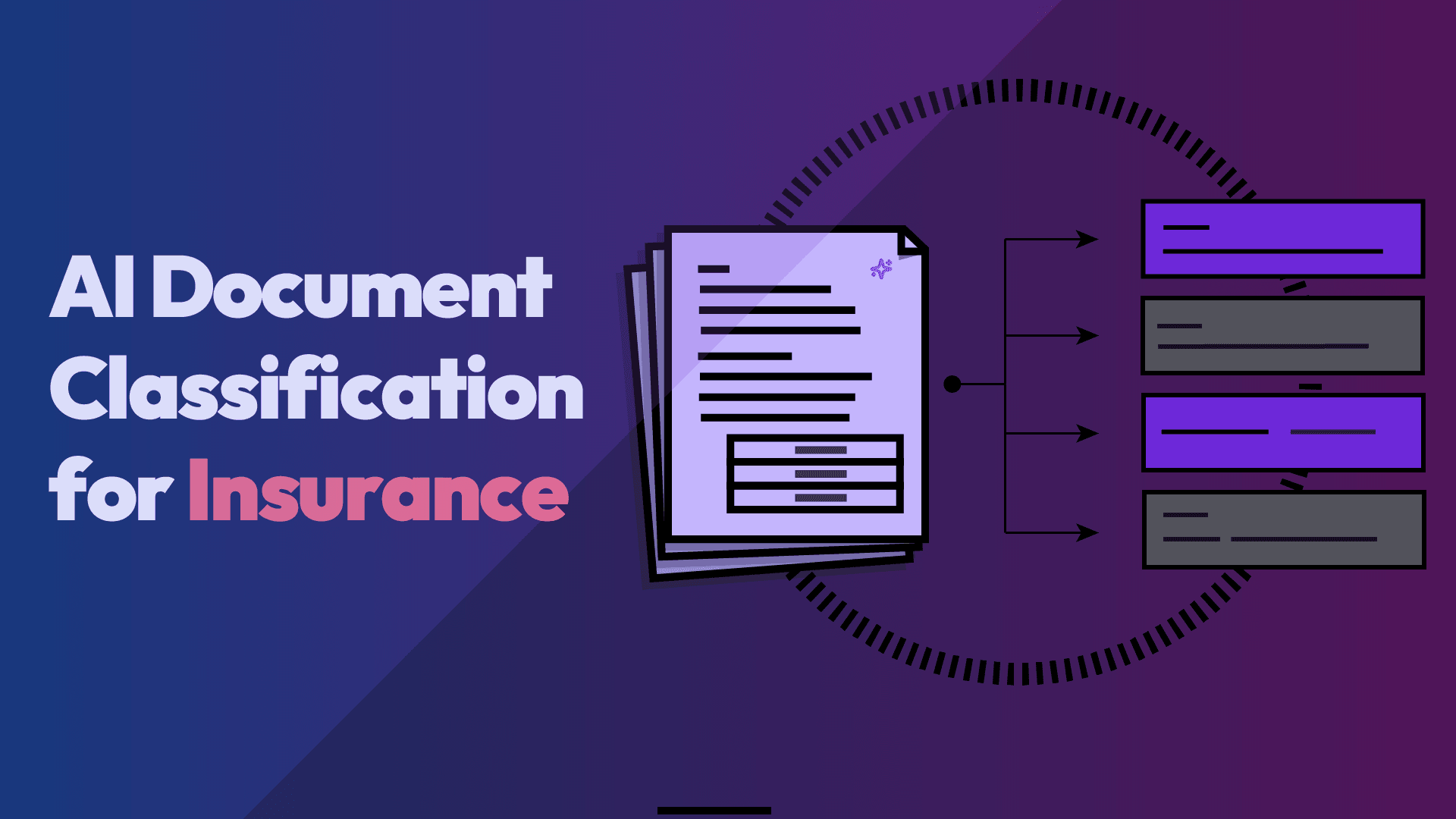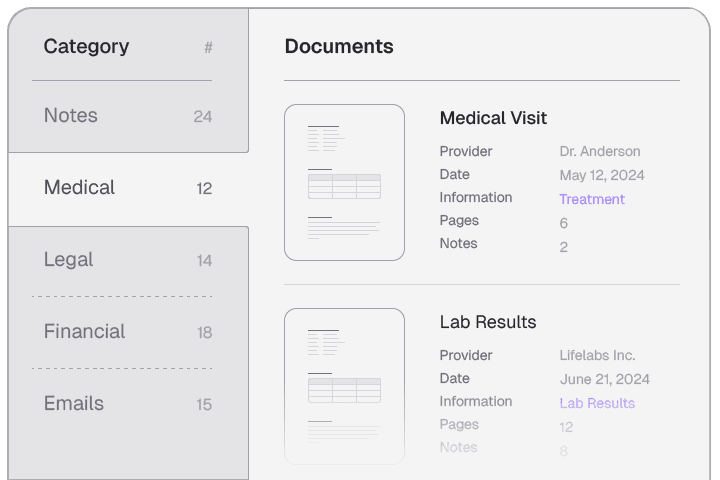
What Is AI Document Classification for Insurance?
How Automated Document Classification for Insurance Liberates Claims Teams to Improve Outcomes
Insurance teams know the burden of document-heavy operations. From claims and legal to investigations and underwriting, managing high document volumes is time-consuming and error-prone.
Imagine sorting through countless claims documents while handling dozens of cases. Even when organized by claim, many documents include different individual documents within document packages.
It's exactly such inefficiencies that cause claims leakage, fraud, and litigation costs to spike.
But what if there was a way to process, segment, and categorize documents faster, more accurately, and with less manual effort? Enter AI document classification for insurance.
This article will break down AI document classification, outline how it works alongside intelligent document processing, and explore its applications & benefits for insurance teams to help them streamline operations and make better & faster claims decisions.
The right document-classification software liberates claims, investigations, and legal teams from tediously searching for critical information, enabling them to focus more on using human judgment and leveraging their creativity & intuition.
The Importance of Document Classification for Insurance
Most insurance executives estimate the industry benchmark for claims leakage at 2–4%, but the average claims leakage is 20–30%—that means insurance claims cost carriers 20–30% more than they should, mostly due to claim complexities and operational inefficiencies.
That's why it's essential to modernize operations with Al for claims processing. For example, using insurance document automation to leverage AI for understanding claims documents or insurance document generation to automatically create internal documents.
But how can claims teams keep up with sorting through and understanding unique claims data? That's what AI document classification delivers.
Document classification for insurance automatically analyzes, segments, and categorizes claims documents so specialists can easily navigate and review information, saving time and gaining the confidence they need to seize accountability for claims decisions.
But how does document classification specifically work and how is its functionality applicable to insurance teams?
What Is AI Document Classification?
At its core, document classification involves organizing and categorizing documents into predefined categories based on their content. AI document classification elevates this process by harnessing artificial intelligence and intelligent document processing.
With advanced technologies like vision-language models (VLMs), AI can process both structured (like forms or invoices) and unstructured data (like emails or PDFs) to sort and accurately label information from documents—even from complex medical or legal files.
How Classification Works with Document Processing
Here are the steps for how document classification works.
First, document-processing technology preprocesses text, removing all unnecessary noise from documents and extracting information into data that's readable by algorithms.
Traditionally, the processed data then trains the machine-learning model, enabling the model to predict what type of documents exist and how to subsequently segment & categorize them.
But without a unique vision-language model, this process can struggle to understand context or even the meaning of unstructured data (e.g., handwritten notes, non-labelled or unformatted information, etc.).
Optical-character recognition (OCR), for instance, reads text by recognizing characters on images or whole document scans. That makes it imperfect when text is scribbled, otherwise hard to read, or outright missing, whether due to bad handwriting or poor scans.
How AI Document Classification Works for Insurance
Advanced vision-language models overcome the limitations of OCR for document categorization.
A vision-language model creates a shared embedding space to understand both text and visuals, learning to decipher missing or hard-to-read text or image patches to better comprehend context and semantics. Then it finetunes itself for specific tasks, like document classification.
Basically, AI document classification for insurance uses intelligent document processing and leverages a vision-language model to accurately segment and categorize claims documents.
For example, OwlVision, Owl.co's document-processing tool for insurance teams, employs a uniquely built vision-language model that deconstructs structured and unstructured documents into their original components, labeling each document for streamlined retrieval.
It then continuously improves its ability to read & label documents and curate document categories based on context unique to insurance claims, thanks to the VLM's best-of-class accuracy and self-learning capabilities.
This way, claims adjusters, lawyers, underwriters, and more can have faith in quickly finding and understanding what they need.

OwlVision automatically segments and classifies documents by category within each separate claim for easy navigation and knowledge discovery when handling insurance claims.
Insurance Applications with AI Document Classification
Imagine a claims adjuster, a physician specialist, or a lawyer receiving large medical files from a hospital, in a master document with hundreds of pages that come in waves.
What's in this or that bundle of documents? Where's that diagnostic report or hospital record? Is there a disability assessment or a medical-information request? And how can I quickly find what I need?
AI document classification for insurance helps teams find critical information and better understand data, enabling:
- claims processing
- fraud investigation
- legal analysis
- underwriting
Benefits include:
- saving time
- optimizing operational efficiency
- reducing claims leakage
- improved insurance decisions
These benefits demonstrate that automated document classification empowers insurance leaders to transform insurance by merging human intuition with technological precision.
Types of Insurance Categories for AI Document Classification
What kinds of categories can frontline workers expect to find with AI document classification?
When AI processes, segments, and classifies insurance documents, teams can navigate dated & autosorted document bundles by category to isolate and analyze specific information about a claim—with no manual document curation, let alone manual filing.
Example categories can include:
- Administrative document
- Correspondence
- Diagnostic report
- Disability assessment
- Hospital record
- Invoice
- Legal document
- Medical-information request
- Office-visit record
- Payroll assessment
- Work-status report
Create the Future of Insurance with Automated Document Classification
AI document classification for insurance processes and organizes data for claims, fraud, and legal teams, using a unique vision-language model for industry-best accuracy.
With document-classification software, insurance teams can help shape the future of insurance with claims intelligence—which combines precise document-understanding with powerful AI technology to enable a liberating power to transform insurance operations.
OwlVision, part of Owl.co's enterprise-level AI toolkit for insurers, includes document classification that enables workers to think critically for better decisions and empowers insurance leaders to spearhead change for industry stewardship.
To learn more about how your organization can benefit from AI document classification, book a demo.
